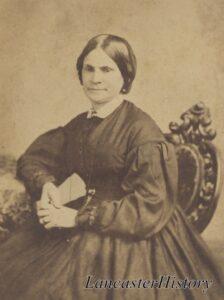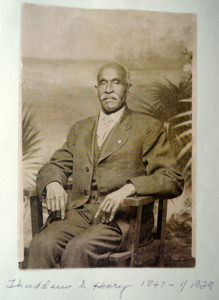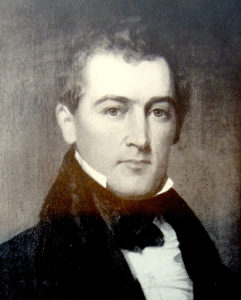African American Heritage Markers
Below is a list of heritage markers that commemorate a wide range of sites and stories significant in Lancaster’s African American heritage. More markers will be added below as more markers are researched, designed, fabricated, and installed. For a list of those potential marker locations, please download a Map & Guide. The Map & Guide was developed by the African American Historical Society with funding from the Walters Trust of the Unitarian Universalist Church of Lancaster, PA.
About Lydia Hamilton Smith
 Lydia Hamilton Smith (1815-1884) was an extraordinary woman who played a pivotal role in the local community. Leaving her husband, she and her two sons arrived in Lancaster in the mid-1840s, seeking the position of house manager for Thaddeus Stevens, a prominent attorney who had relocated to the city two years prior. Mrs. Smith was hired for the position and remained in her role for 24 years, diligently managing Stevens’ household and affairs in Lancaster and Washington D.C., even during his tenure in the U.S. Congress. She provided essential healthcare to Stevens in the declining years of his life enabling him to finish his Congressional work and the passage of the 13th and 14th Amendments to the US Constitution.
Lydia Hamilton Smith (1815-1884) was an extraordinary woman who played a pivotal role in the local community. Leaving her husband, she and her two sons arrived in Lancaster in the mid-1840s, seeking the position of house manager for Thaddeus Stevens, a prominent attorney who had relocated to the city two years prior. Mrs. Smith was hired for the position and remained in her role for 24 years, diligently managing Stevens’ household and affairs in Lancaster and Washington D.C., even during his tenure in the U.S. Congress. She provided essential healthcare to Stevens in the declining years of his life enabling him to finish his Congressional work and the passage of the 13th and 14th Amendments to the US Constitution.
To read more about Ms. Smith, please click here.
About William and Isaac Smith
William Smith (1835-1861) and Isaac Smith (1837-1884), Lydia’s sons, were born in Gettysburg. In 1852, William, Isaac, and their friends established the Shiffler Fire Company, a brigade of neighborhood volunteer firefighters. Thaddeus Stevens gave the brigade access to a building on his property where they gathered and stored their equipment. Tragically, William died at the age of 26 from a self-inflicted gunshot wound that occurred at Stevens’ home. While different newspapers presented varying accounts, some referring to the incident as an accident and others claiming it was a case of suicide, the community mourned the loss of this young man.
Isaac, also known as “Little Ike,” followed in his father’s footsteps and became a barber and talented banjo player. Isaac later served as a private in the Union Army, Sixth Regiment, Company D, United States Colored Troops, from July 10, 1863, until December 15, 1864. After the war, he operated a barber shop in what had been Congressman Stevens’ law office at 47 South Queen Street. Notably, Lydia acquired the property in 1871, purchasing it from Stevens' estate.
Unfortunately, Isaac’s life was cut short, passing away in early April 1884, only two months after his mother’s death. The inscriptions on all three family members' gravestones have led to questions about their birth and death years. Lydia’s gravestone states that she was born on the feast day of Saint Valentine in 1813, while her death certificate and multiple obituaries suggest her birth year as 1815. Similarly, Isaac’s gravestone claims that he died “in his 37th year,” yet obituaries from Lancaster newspapers report his age at 48. Finally, the year of William's death is 1861, according to newspaper accounts, not May 10, 1860 as seen on his gravestone. The recently installed marker illustrates these discrepancies.
Further Reading
**Please Note: The below documents in this section are large files. We recommend users access them while on Wifi to avoid data issues.
For more information regarding the research and conservation behind the gravestone restoration, please view the Hamilton Smith Cemetery Plot Report [PDF; 4.87mb].
For more information on the lives of Lydia Hamilton Smith and her sons, William and Isaac, please view the Lydia Hamilton Smith & Sons Background Information Report [PDF; 12.1mb].
Sponsors
Thank you to the following community organizations, businesses, and individuals for their sponsorship of the historical marker and restoration of the gravestones!
African-American Historical Society of South Central PA
Charles F. Snyder Funeral Homes & Crematory
Heritage Monuments
LancasterHistory
Randy Harris, LancasterHistory
Andre Dominguez, LancasterHistory
Robert Mosko, Mosko Cemetery Monument Services
Paul Hubbs, LancasterHistory
About Thaddeus S. Henry (1815-1897)

Henry was born in Philadelphia and moved to Lancaster when a lad of ten years. He learned his trade with Benjamin Simmons, and afterwards entered the tonsorial business in his own interests. In the pursuit of this vocation he was eminently successful... - from Death of an Aged Barber, Thaddeus S. Henry's obituary, The Daily New Era, May 17, 1897
By 1873, Thaddeus' barber shop occupied the first floor of a three-story brick building at 15 East King Street, the present site of Fulton Bank. His services were sought by the most prominent men of the day, among them President Buchanan and Hon. Thaddeus Stevens.
Right Image: Thaddeus S. Henry, Jr. (1847-1924), son of Thaddeus S. Henry, Sr., notable barber. Courtesy of Catherine Tucker.
Further Reading
Additional research has been conducted by Kathleen Anderson of Lancaster, PA, the great-great granddaughter of Thaddeus S. Henry, Sr., and a member of the African American Historical Society of South Central PA. Click here for more supplementary information included on the historical marker dedicated to Thaddeus S. Henry installed at 15 East King Street in Lancaster, PA.
Sponsors
This commemorative marker is made possible by support from Fulton Bank. Thank you!

Design and illustration of the marker by Michael Abel and Randolph Harris. Additional research on Thaddeus Henry by Kathleen Anderson.

About The Fulton Opera House
A National Historic Landmark, the Fulton Opera House in Lancaster, Pennsylvania ranks among the nation's oldest continually operating theaters. It also marks the site of a dramatic episode in the history of the Underground Railroad when the property was the location of the original Lancaster County Jail. Lancaster County 18th-century Prison and Workhouse complex was demolished down to its foundations in 1851. On portions of those stone walls, Fulton Hall, as it was called originally, was built. Remnants of those stone walls are visible along North Water Street.
African-American Women Flee County Jail, 1835
It was from this now mostly demolished lockup that an unusual and daring escape occurred in 1835. Two formerly enslaved women of African descent, living in freedom in rural Lancaster County, were seized by bounty hunters as runaways. They were held in the jail on a temporary basis, pending transport to Southern states. However, they were secretly released by an unlikely co-conspirator: the chief law enforcement officer of Lancaster County, Sheriff David "Dare-Devil Dave" Miller (1795-1858). The women told sympathizers that they escaped themselves, apparently to "cover" Sheriff Miller. However, the Sheriff later admitted his involvement to a confidante.
Sheriff David "Dare-Devil Dave" Miller (1795-1858)

Miller was elected to his post as an Anti-Mason. This colorful character was a humanitarian, avid horseman, and suppressor of race riots against African Americans. He was also a military veteran, hotel owner, early railroad entrepreneur, and, according to local tradition, a support of the region's Underground Railroad. Miller's secret release of the women was documented in 2008 report to the National Underground Railroad Network to Freedom, earning the Fulton--with its workhouse foundations--the designation as a site with an authentic connection to the Underground Railroad.
Sponsors

About William G. Payne
William G. Payne was born in October 1847 as one of eight children to Susan and (Harry?) Payne. It is probable that the Payne family resided in the District of Columbia prior to William's move to Addison Street in Philadelphia. In Philadelphia, William founded a successful catering business before moving again to Lancaster with his wife, Hermione Dova, and his widowed mother. Once in Lancaster, William started a restaurant and catering business at 27 East Orange Street and, as his success and reputation spread, he was later hired as Caterer and Steward for the Hamilton Club. In 1906, William leased 135 East Grant Street and opened the Lancaster Kitchen & Caterers' Supply Company, which he owned and operated from 1906 to 1914.
William's wife, Hermoine, passed away on December 22nd, 1901 at 50 years of age. He would go on to remarry eight years later to widow Benidene Brown Hill of Washington, D.C. William would continue to be active in the Lancaster community, and was active in founding and forming the Ebenezer Baptist Churck.
William Payne died on July 29, 1919 at 72 years of age and was buried in Washington, D.C.
Location of Historic Marker
A historic marker dedicated to William G. Payne is located at 135 East Grant Street in Lancaster, PA.
Further Reading
To learn more about William G. Payne, click here to download supplementary material and research. The document offers additional information in supplement to the public tours conducted by the African American Historical Society of South Central Pennsylvania.
Sponsors
This commemorative marker is sponsored by the Walters/Unitarian Universalist Church Trust, the African American Historical Society of South Central Pennsylvania, and LancasterHistory.
